A sample text widget
Etiam pulvinar consectetur dolor sed malesuada. Ut convallis
euismod dolor nec pretium. Nunc ut tristique massa.
Nam sodales mi vitae dolor ullamcorper et vulputate enim accumsan.
Morbi orci magna, tincidunt vitae molestie nec, molestie at mi. Nulla nulla lorem,
suscipit in posuere in, interdum non magna.
|
Brazilian biomes
In its 8.5 million square kilometers, Brazil possesses fantastic landscapes and may be the richest country on earth in biological diversity. Landscapes range from semi-desert to evergreen tropical rain forests.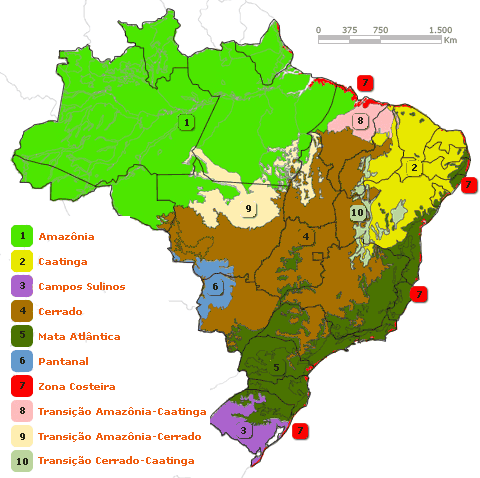 |
 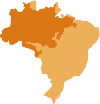 The Amazonia, an area of nearly 5 million square kilometers, occupies nearly the whole northern part of South America up to the Andes. The Amazon forest is a tropical rainforest with one of the world’s highest rates of biodiversity and also the most intact areas. It impresses the visitor with its endless landscapes of green forest and colourful waters. The Amazonia, an area of nearly 5 million square kilometers, occupies nearly the whole northern part of South America up to the Andes. The Amazon forest is a tropical rainforest with one of the world’s highest rates of biodiversity and also the most intact areas. It impresses the visitor with its endless landscapes of green forest and colourful waters. |
  In the bulge of north-eastern Brazil, too far from the moist Amazon inland and the ocean currents on the west l lies the Caatinga characterized by scrubs, thorns, magnificent cactus formations and small contorted trees. Though this ancient land is also one of the poorest regions of the country, where years of drought can occur, its flora and fauna is surprisingly rich and it is home to some of Brazil´s most important pre-historic sites. The disappearance of the Atlantic Rainforest, amongst other factors, is increasing the desertification pressures on this unique ecosystem. In the bulge of north-eastern Brazil, too far from the moist Amazon inland and the ocean currents on the west l lies the Caatinga characterized by scrubs, thorns, magnificent cactus formations and small contorted trees. Though this ancient land is also one of the poorest regions of the country, where years of drought can occur, its flora and fauna is surprisingly rich and it is home to some of Brazil´s most important pre-historic sites. The disappearance of the Atlantic Rainforest, amongst other factors, is increasing the desertification pressures on this unique ecosystem. |
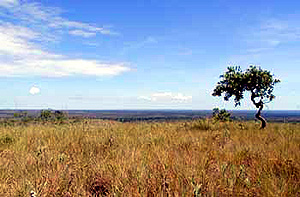  The Cerrado has a plant community structure similar to the African savanna, but is much richer in biodiversity. Running diagonally from southwest to northeast, this is the heartland of Brazil where magical landscapes enchant the visitor. The Cerrado is also important as a corridor for animal and plant species to other ecosystems Brazil. The rapid expansion of Brazilian agriculture has greatly reduced the cerrado, which occupies 25% of Brazilian territory and makes it a conservation hotspot. The Cerrado has a plant community structure similar to the African savanna, but is much richer in biodiversity. Running diagonally from southwest to northeast, this is the heartland of Brazil where magical landscapes enchant the visitor. The Cerrado is also important as a corridor for animal and plant species to other ecosystems Brazil. The rapid expansion of Brazilian agriculture has greatly reduced the cerrado, which occupies 25% of Brazilian territory and makes it a conservation hotspot. |
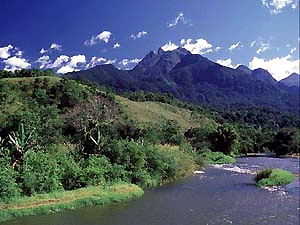 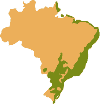 The Mata Atlantica which once covered an area of 1.1 million kilometers has been diminishing since the discovery of Brazil . Only 5% of the original forest area remains and it is one of the most endangered areas in the world. However, the remaining forest is still a biodiversity hotspot. The Atlantic Forest is an intimate and mysterious place offering encounters with the threatened species who find their home only in this forest. The Mata Atlantica which once covered an area of 1.1 million kilometers has been diminishing since the discovery of Brazil . Only 5% of the original forest area remains and it is one of the most endangered areas in the world. However, the remaining forest is still a biodiversity hotspot. The Atlantic Forest is an intimate and mysterious place offering encounters with the threatened species who find their home only in this forest. |
  The largest wetlands in the world is the Pantanal. These spectacular floodplains, lying South of the Amazon and to the Southwest of the Cerrado, show influences of both these ecosystems. Considered to have the highest concentration of wildlife in the Americas, the Pantanal is a must for nature lovers, who will marvel both the abundance and the diversity of animal species and its beautiful sunsets in this wild frontier. The largest wetlands in the world is the Pantanal. These spectacular floodplains, lying South of the Amazon and to the Southwest of the Cerrado, show influences of both these ecosystems. Considered to have the highest concentration of wildlife in the Americas, the Pantanal is a must for nature lovers, who will marvel both the abundance and the diversity of animal species and its beautiful sunsets in this wild frontier. |
  In the very South of Brazil, lie the Pampas. These beautiful grassland are bordered on the north by araucaria forests and canyons. In the very South of Brazil, lie the Pampas. These beautiful grassland are bordered on the north by araucaria forests and canyons.
Apart from grasslands associated with ‘Cerrado’ and Atlantic Forest, there are also the Pampas of southern Brazil. Unfortunately, the Pampas have largely been destroyed for pasture and rice plantations. Good examples can be found in the Taim Ecological station and the Lagoa de Peixe National Park, which are key stopovers for migrating birds. |
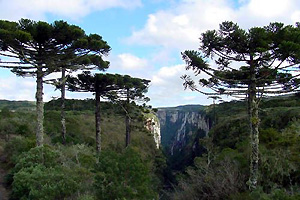 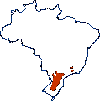 Augustifolia Forest In the Brazilian Southern Plateau, with altitudes in excess of 500m, is the area of distribution for the pinheiro (pine tree) do Paraná, Araucaria angustifolia, that occupies about 2,6% of the national territory. In these forests, representatives of the tropical and temperate flora of Brazil coexist, being dominated, however, by the pinheiro-do-Paraná. The forests vary in arboreal density and height of the vegetation and can be classified according to the soil aspects, as alluvial, along the rivers, sub-mountainous, that no longer exist, and mountainous, the major one dominating the landscape. The open vegetation of the gramíneo-woody fields occurs on shallow soils. Due to its high economic value the Forest of Araucaria is suffering from intense deforesting pressure. Augustifolia Forest In the Brazilian Southern Plateau, with altitudes in excess of 500m, is the area of distribution for the pinheiro (pine tree) do Paraná, Araucaria angustifolia, that occupies about 2,6% of the national territory. In these forests, representatives of the tropical and temperate flora of Brazil coexist, being dominated, however, by the pinheiro-do-Paraná. The forests vary in arboreal density and height of the vegetation and can be classified according to the soil aspects, as alluvial, along the rivers, sub-mountainous, that no longer exist, and mountainous, the major one dominating the landscape. The open vegetation of the gramíneo-woody fields occurs on shallow soils. Due to its high economic value the Forest of Araucaria is suffering from intense deforesting pressure. |
 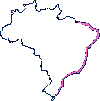 Mangrove swamps, Manguezais, are found on many locations of the Brazilian coast, where rivers meet the sea. Unfortunately, many have been partly destroyed. Impresssive formations can still be found in the Lagamar area (border of the states of São Paulo and Paraná), the bay of Camamu (Bahia), the Parnaiba Delta (Piaui) and around the mouth of the Amazon. Mangrove swamps, Manguezais, are found on many locations of the Brazilian coast, where rivers meet the sea. Unfortunately, many have been partly destroyed. Impresssive formations can still be found in the Lagamar area (border of the states of São Paulo and Paraná), the bay of Camamu (Bahia), the Parnaiba Delta (Piaui) and around the mouth of the Amazon. |
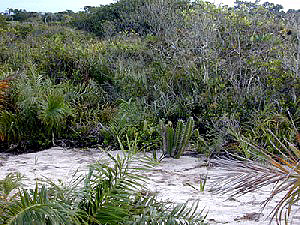 Restinga is a coastal strip vegetation adapted to the extreme conditions of burning sun, strong winds, salty air and sandy soil. The vegetation includes cactus and thorny shrubs and also cashew nut. Restinga is a coastal strip vegetation adapted to the extreme conditions of burning sun, strong winds, salty air and sandy soil. The vegetation includes cactus and thorny shrubs and also cashew nut. |
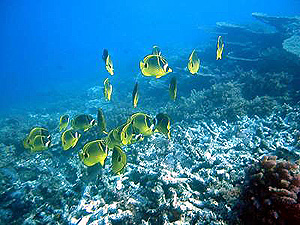 Coral reefs can be found in many places along the Brazilian coast. Many of the northeastern beaches have natural coral reef pools. The largest coral reef formation in the South Atlantic is Abrolhos National Marine Park (Bahia), which is also a nursery for humpback whales. The other Marine Park of Brazil is Fernando de Noronha (Pernambuco), a volcanic island that is a top diving spot and also great for surfing. The Reef of Manoel Luis, 185 km off the coast of Maranhão, is considered one of the wonders of the underwater world. It is very difficult to visit however because of its remote location, high waves and strong currents and needs a special permit. Coral reefs can be found in many places along the Brazilian coast. Many of the northeastern beaches have natural coral reef pools. The largest coral reef formation in the South Atlantic is Abrolhos National Marine Park (Bahia), which is also a nursery for humpback whales. The other Marine Park of Brazil is Fernando de Noronha (Pernambuco), a volcanic island that is a top diving spot and also great for surfing. The Reef of Manoel Luis, 185 km off the coast of Maranhão, is considered one of the wonders of the underwater world. It is very difficult to visit however because of its remote location, high waves and strong currents and needs a special permit. |
|
|